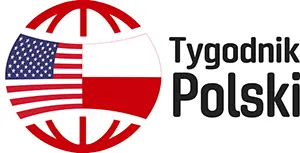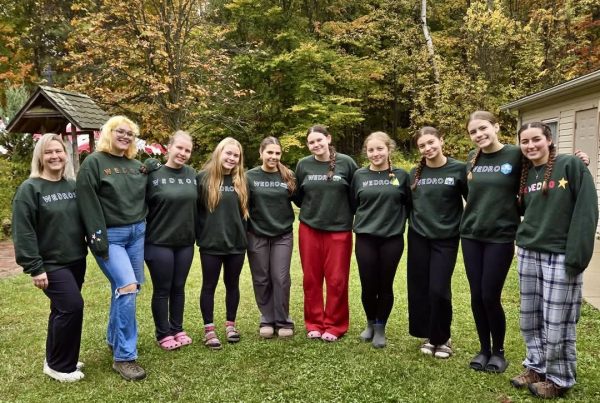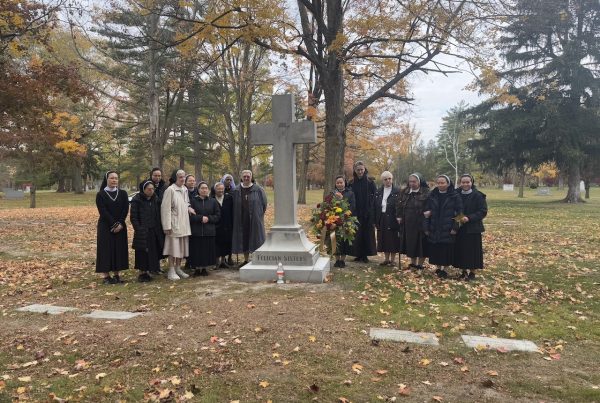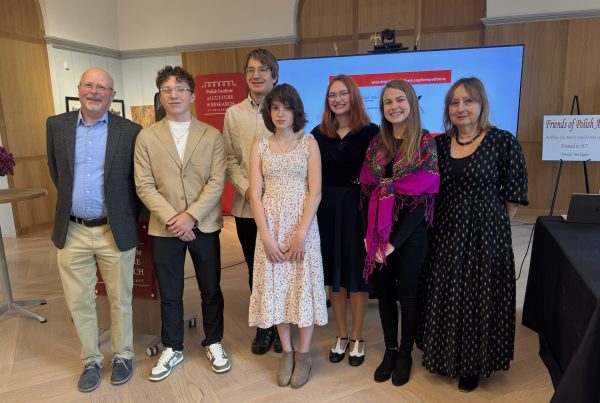Polish immigrant stories: some have very dramatic beginnings, followed by twists and turns of fate, others are perhaps less dramatic but equally fascinating. All are worth preserving as they contribute to the larger picture of our Polish American history.
Not everybody came here as a political or economic immigrant. Barbara Lisiecka came here following her heart. She was smitten with Stachu, her American boyfriend, but also curious and excited about the United States.
I have known Barbara for a long time. What I observed and admired for years was her dedication to the promotion of Polish culture as well as her many artistic talents. I am sure that true Polish cuisine has gained numerous aficionados thanks to Barbara’s skills and efforts. As Barbara is soon leaving for Sarasota, Florida, I felt that this was the time to find out more about her roots and her Michigan life. We met at Barbara’s house in Farmington Hills where we spent a few hours in conversation.



Beginnings
Barbara is the mother of Mikołaj, who works at Sony Corporation in California, and Oleńka, a very well-known in our area proprietor of “Recultured Design”, also currently living in California.
Nowadays Barbara, after she introduces herself, often hears – oh, are you the mother of Oleńka Lisiecki? However, before Oleńka became successful with “Recultured Design”, Polish Americans knew Barbara as the co-owner of “Sunset Travel Agency”, which she operated for 38 years (1982 – 2020) out of Warren, with her friend Ania.
Like other Polish immigrant stories, Barbara’s story is tightly interwoven with her homeland and the Detroit Polish American community which became her new home. Barbara did not know English when she arrived in the US, yet her story is not one of alienation or feeling uprooted. It is rather the story of a talented, full-of-hope-and-optimism young woman, who embraced the opportunities the new country, new family and community offered her, worked hard, persevered and very quickly started contributing to her new community.
Barbara, a native of Lublin, arrived in Detroit in 1976, as the 22-year-old bride of US-born Stanisław (Stachu) Lisiecki. They sailed on the famous Polish transatlantic ship “Stefan Batory”, although at the time this way of reaching America was becoming less popular due to the growing availability of flights. In Gdynia they boarded the ship bound for Montreal. Unfortunately, due to stormy weather and seasickness, Barbara spent the entire two-week-long crossing mostly in her cabin, and could not enjoy the balls, concerts and other attractions which were offered during the voyage.
Barbara met her future husband, Stachu, at the Catholic University of Lublin (KUL), when she was a second-year history student there, and he was working on his master’s degree. Three months earlier Stachu, who received his bachelor’s degree in Polish studies from U of M, Ann Arbor, got invited to KUL by Prof. Mieczysław Krąpiec, the university president at the time. Stachu quickly won Barbara’s heart. He was intelligent and calm, a true gentleman with a very impressive knowledge of Polish history. Once in the US, Barbara continued her quest to learn about topics which in communist Poland were forbidden, such as the Katyń massacre, the Yalta agreement or the deportation of Poles to Siberia during the 1940s. The availability of the information and freedom to explore it amazed her; it was so different from what she knew in Poland, where such topics were hardly ever discussed, and then only with a very few trusted people. The books she read were in Polish, and it was Stachu who ordered them from Polish bookstores in London and Paris.
Their mutual interest in history was a big factor in bringing Barbara and Stachu together. However, the idea to study history went against what Barbara’s parents, people of some financial means, dreamed for their daughter.
Having one’s own business in communist Poland – and only a few people had them – was usually very lucrative. Be it making plastic gadgets, or furniture, operating a taxi or a car repair shop. Horticulture (known as “badylarstwo”) was one of them as well and that’s where Barbara’s parents saw her future: as an owner of a profitable greenhouse, growing vegetables and flowers. So Barbara obediently graduated from a technical high school of horticulture (technikum ogrodnicze), but then, instead of continuing her studies at an agricultural university, she enrolled in a history program at KUL.
Nevertheless, her parents supported her decision as well as the other choices she made later. It was her parents from Poland who helped her in 1982 to obtain the “Sunset Travel Agency”. They believed that it would be a business which would provide a livelihood for her family for years to come.
I asked Barbara why she wanted to work as a travel agent. Her answer was: she had to do something, and her opportunities were still rather limited. Also, this profession seemed quite suited to her due to her outgoing, energetic and very sociable personality.
Barbara’s mother-in-law, Irena Lisiecki (1921 – 2009), was a very active member of the Polish American community. She worked full time for Dziennik Polski (Polish Daily) as a writer, translator and editor. Soon Barbara, as a volunteer, had her chance to occasionally write for the paper about Polish folklore and traditions.
Irena was also involved with the Polish Catholic University Association “Vertitas”, so Barbara became the youngest member of this organization. She remembers meetings during which they discussed such topics as Mother Theresa of Calcutta or Catholic missionary work, especially missions conducted by Polish missionaries in Africa and South America, which “Veritas” supported financially. On occasion Barbara even gave short talks about “Veritas” on the local Polish radio program, Polish Varieties, a very popular two-hour-long program, which was aired live every day. At the time, Polish Varieties was produced by Cecylia (Celia) Kreutz who in 1975 took it over after the death of her husband, Jan Marian Kreutz, a prominent – one can say legendary – radio journalist.
“Veritas” was established in London during WWII and most likely was transplanted to the US together with the Polish immigrants arriving here a few years later. One of the newcomers was Irena’s future husband, Wacław Lisiecki (1902-1973) who married Irena, then Kołodziejczak, in 1949.
Although Barbara didn’t have a chance to meet her father-in-law – he died three years before her arrival – she spoke about him with a lot of admiration, describing him as a true Polish patriot who during WWII fought in the 304 Bombing Squadron of the RAF (Royal Air Force) as a navigator. Among the family memorabilia Barbara cherishes, there is an envelope sent from London and addressed to Miss Irena Kołodziejczak, dated1946. For years Barbara kept Wacław’s black luggage trunk with stickers representing places he travelled to before he reached the US. Now the trunk is on display at Barbara’s son’s house in California.
Barbara’s first paying job was painting – or rather writing, as this is the proper word to describe the process – of orthodox icons, her husband’s idea, who was very involved with the Greek Catholic Church. Although she was not a painter, Barbara, a quick study, soon started receiving orders to create icons of patron saints. The special wood she used was obtained from Zakopane while the pigments were made according to old recipes.
Also due to Stachu’s contacts, in 1981, Barbara made and sold hundreds of pisanki, after her photo with a basket of them, and the information that people could purchase them from her, was published by the Detroit Free Press under the heading “Wesołego Alleluja”.


Travel agent
In 1982, at the time when Barbra and her friend Ania started operating “Sunset Travel Agency”, Barbara was six years into her American life, a wife and mother of two small children, an icon painter, and pisanki maker, with a considerable amount of volunteering in the Polish American community under her belt. She missed her family in Poland very much. She wanted to share her experiences with them but to call them, she had to order the call through an operator, then wait for the connection, and pay $5.00 for every minute she spent with them on the phone. As a young and open-minded person, she assimilated quickly, but still there was plenty of inevitable hardship.
Let’s recall that Polish travel agencies, of which only few are left now, were once very important places which helped Polish immigrants not only with sending money and packages to Poland, and buying airplane tickets, but also with essential day to day issues such as immigration procedures and even on occasion – as Barbara recalls with a smile – finding a life partner. They were hubs of social activities where people got advice and often help, as well as information about available employment.
When Barbara and Ania started in the business, there were 12 of them in Metropolitan Detroit, three under the name Amerpol. Due to the increased competition in the airline industry, Pan American (which went bankrupt in 1991) offered handsome kickbacks from ticket sales to agents who had a special agreement with them. So did the Polish bank PKO, which was the only bank that could be used to send money to Poland. These profitable deals were very soon a thing of the past, nevertheless Sunset Travel continued serving and helping their customers for many years.
One of big perks, however, which came with being a travel agent, were the many opportunities to travel. Basia’s favorites destinations were smaller countries in South America: Ecuador, Guatemala and Honduras. When she was elected General Secretary of SPATA (Society of Polish American Travel Agents) which connected over 250 agents from the US, and later from countries such as New Zealand and Australia, she often traveled first class. The SPATA was established in 1959 as a forum for sharing experiences and promoting tourism to Poland and it still exists.
One of the most memorable trips Barbara took was a cruise down the Dnieper River, during which she saw the famous Cossack horses in Zaporozhe, and even rode a black million-dollar stallion.



Promoting Polish culture
However, had Barbara had her dream business, it would have been a restaurant, not a travel agency. She thinks that the best fit for her would have been a small Polish-style restaurant, with the menu including different kinds of naleśniki (savory ones with spinach as well), potato pancakes, racuchy (apple fritters), desserts and other simple Polish dishes less popular in America. She had this idea, but did not have the necessary funds to realize it.
Barbara is famous among her friends and acquaintances for her delicious cooking and baking – but also for food presentation, which includes making beautiful bouquets and arranging unforgettable tables with food.
Twice, in 2011 and 2012 she organized the Chopiniana (the dinner and concert, a musical tribute to Chopin) at the American Polish Cultural Center; it was after Chopiniana’s founder Noreen Śmiałek-Sinclair died and before Jackie Kolowski took over the organization of this important Polish American cultural event.
Barbara remembers the first event she organized like it was yesterday: tall vases with blue delphinium, treble clefts made of dough which she baked for each of over 200 guests, and individual dinner plates, decorated with lettuces she bought at Eastern Market. The pianist was a young man from Białystok, who came to the States with his father.
It was interesting to find out how Barbara, undoubtfully a woman of many artistic talents, acquired these particular skills. It turns out that while in high school, she had a friend whose family preserved a good deal of pre-war Polish gentry ways of life including elaborate, traditional food preparation and serving. Spending weekends with them Barbara learned how to bake and decorate cakes, especially mazurki, arrange flowers, and what kind of fork, spoon or knife goes with what. Remember, this was in communist Poland, with basic food shortages, and hardly any restaurants. Finding the ingredients needed to make these mazurki, such as different kind of nuts, oranges, lemons, raisins, etc., was a real challenge.

When, in 1977, together with Stachu, dressed in beautiful Lublin folk attire, she represented the Polish ethnic group during a national governors’ meeting at the Renaissance Center, she was shocked and even ashamed when she saw the Polish foods that were served there: gołąbki, pierogi, kapusta, kiełbasa and kopytka. For her, as for many new arrivals from Poland, these were everyday peasant dishes, not food one offers when entertaining such esteemed guests.
Very soon, however, her eyes opened wide, when she saw how popular these very foods were with the guests, who enjoyed them and crowded the impromptu Polish restaurant, at the same time forgoing – for instance – exquisite Swiss cheeses. Kopytka was the biggest hit, while Swiss cheeses had hardly any takers.
Over the years Barbara not only baked exquisite mazurki for Święconka at the APCC (in its early days), but also conducted there a few pisanki (egg decorating) workshops. She learned how to make pisanki, with hot wax and multicolored dies, from her grandmother who lived in a village near Lublin. Spending time with her grandmother as a child, witnessing traditional celebrations such as dożynki, had a big influence on her and sparked her interest in and love of Polish folklore.
In 2005 – 2008 Barbara published two editions of “The Michigan Polish Connection”, a biannual publication with a comprehensive listing of Polish businesses and organizations. Two such directories were published, and they remain an important source of information about Polish American life twenty years ago. Among Barbara’s collaborators were her son Mikołaj (artistic director) and Tomek Kielar.



Seamstress?
When she was a young girl, her mother would often say that Barbara – because supposedly she had a crooked finger – would be a seamstress. After all, her father was a very talented designer and cutter of cloth who worked for the fashion company “Gracja”, which sold clothing to countries of the Communist Bloc. Both the company, and Barbara’s father made very good money doing it. But for a few decades nothing indicated that Barbara would ever be involved in the fashion business. This changed rather abruptly, when one day her grown daughter Oleńka called her after the mass at St. Florian’s to announce that she wanted to start a business and make clothes with folk motifs. Barbara still remembers Oleńka saying, “I will be designing, you will be sewing, as you know how to operate the sewing machine.”
At first, Barbara was a little disappointed, as Oleńka had a MD in Trans-Atlantic Studies from Jagiellonian University, in addition to two other degrees. Nevertheless, like her parents who always supported her, she embraced Oleńka’s idea and helped her out.

Polonia
During her many years in Michigan Barbara had opportunities to be around older Polish American women: strong, patriotic but also – one might say today – very “old world”, especially when their age was considered.
Gina Falkowski, for instance, who Barbara lovingly took care of for 11 years, and who died at 102, when asked: “Gina, ile ty masz lat?” (“How old are you, Gina?”), would always jokingly reply, but never mention her actual age: “Tyle, ile na stodole łat! A każda łata, po trzy lata!” (“As old as the number of patches on the barn, and each patch is three years old!”)

Both Irena Lisiecki and Gina Falkowska were born in the US, and both with their families went to live in Poland during the economic recession before WWII. Irena’s father, who built half of Hamtramck, upon their arrival in Poland bought a big tenement building in Bydgoszcz on the main street, and a villa in Poznań, as all four of his children were supposed to study in Poznań. The Kołodziejczaks’ – Irena’s family – survived the war in Poland and were able to go back to the States shortly after. Gina’s two sisters also left Poland at the same time, while Gina followed them to the States in the 1960s; earlier she worked at the American Embassy in Warsaw.
I decided to include this information in Barbara’s story, as it is not so much known any more that some Polish American families before WWII decided to go back to Poland to avoid the economic downturn.
When Barbara reflects on Polonia of the late 1970s and 1980s, she describes it as a much bigger Polonia, “being Polish” every day, while now, she sees Polish Americans as “being Polish” only on holidays. Many of the people she met back then came from England and were Polish intelligentsia with university degrees from Poland or England. During the time of communism, and especially the hard times of martial law, Polonia was more unified, while now, like American society in general, it is polarized and divided.
Barbara remembers how her family had to get to church in Orchard Lake half an hour before the service as it was so crowded, especially on special occasions, when many people wore folk attire. It was a completely different world; it was like a continuation of the 19th century, preserving celebrations and folk traditions, and she loved it.
These Polish Americans were very patriotic; they made their kids speak Polish, while those who immigrated later, the immigrants from the “Solidarity” era for instance, did not always expect it from their kids.
But these were the times when Polish Americans also suffered discrimination, experienced prejudice and were often the butt of so-called Polish jokes. Barbara vividly remembers a mug, with the handle inside it, and the description “Polish mug”. She never experienced discrimination, but she knew people, who to avoid it, changed their Polish-sounding names to name such as Johnson or Smith.
Both Barbara’s children, when young, spent almost every summer with her parents in Poland. They were also members of the Polish Scouting Organization. Mikołaj, who left Michigan 20 years ago, still when talking with Barbara speaks Polish even when explaining some technical aspects of his job. So does Oleńka. In addition to being fluent in Polish they also speak Ukrainian, as they attended the Immaculate Conception Catholic Schools. These are well-educated, successful, Polish Americans, who when asked, proudly announce that they are Polish.
I did not ask Barbara what she consider her biggest American accomplishment, but I think I know what her answer would be.
I would like to thank Barbara for sharing her story with me and the readers of the Polish Weekly. I wish her all the best in Florida, where she has already made some friends, became a member of the Polish American Association of Sarasota and the Florida Chapter of the Kosciuszko Foundation, not to mention that she treated her new friends to her exquisite mazurki and pączki. Whoever has tasted Barbara’s pączki would agree that they are unparalleled.

Photos used in the article:
Collection of Barbara Lisiecka,
The Detroit Free Press, Sunday, March 29, 1981,
Thank you to Ewa Gala for an illuminating conversation about Polish travel agencies.









